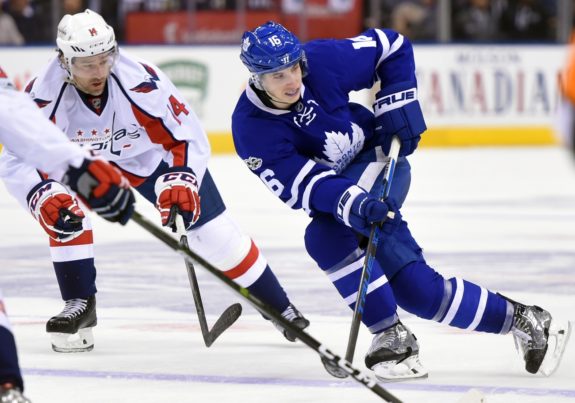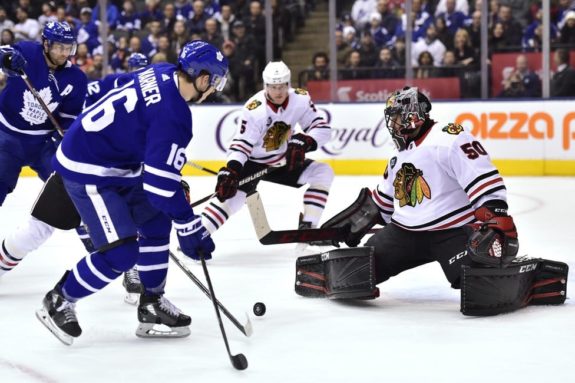In one of the most unexpected and round-about ways possible, Toronto Maple Leafs general manager Kyle Dubas has created the cap space needed to sign restricted free agent (RFA),

(John E. Sokolowski-USA TODAY Sports)
The 35-year-old Clarkson suffered a career-ending back injury with the Columbus Blue Jackets during the 2015-16 season, but his contract will still be paid until the end of next season. Clarkson has been on long-term injured reserve (LTIR) since 2016 and will remain on it with the Leafs until his contract expires after the 2019-20 season. By making the trade, Dubas leveraged that contract to create space the Maple Leafs need to sign Marner.
Related: Maple Leafs News & Rumors: Nylander, Babcock, Marner & Offer Sheet
The Complexity of the Trade
The gist of the trade is that the Leafs will place Clarkson and his contract, which carries a cap hit of $5.25 million, on LTIR. Then, on Oct. 2, when the regular season starts, the team will also add Nathan Horton’s similar contract to LTIR, those moves will allow Toronto to generate about $10.55 million in space.

Sportsnet’s Elliotte Friedman explained the specifics of the trade:
“Remember the number $13 million. That’s basically what Toronto’s just done. Between David Clarkson’s contract, which has a year left on it and the bonus has been paid so most of the money has been paid out, Nathan Horton’s contract, which has a year left on it, and I think they will also probably have Dermott and Hyman on long-term injury at the start of the season — although both of those guys are coming back — between all four of those guys they’ve got about $13 million at the beginning of the season in dead money. So depending on what happens with Marner and depending what happens with anything else they want to do, right before the season they’re going to get as close to the cap as they can, then they’re going to put all these guys on LTIR. It’s going to give them some flexibility to do some things with their roster. Basically, they bought extra cap space to keep flexibility at the beginning of the year.”
What Does This Mean for Signing Marner?
The trick in this deal is how the LTIR works.
First, the Maple Leafs are allowed to go over the $81.5 million salary cap by 10 percent during the off-season, but they are required to be under the limit by the start of the season.

Second, if the team puts both Horton and Clarkson on LTIR when they are at the maximum $81.5 million in salary, they will be given the amount of about $10.5 million in salary cap relief for those two players on LTIR.
Third, adding Horton and Clarkson to the LTIR doesn’t eliminate their cap hits, but their contracts won’t count against the salary cap limit. Thus, the Maple Leafs will be allowed to exceed the cap by the amount that’s on the LTIR, which is the addition of both these contracts.
Related: Maple Leafs & Golden Knights Swap Sparks, Clarkson
Fourth, this move might save them enough cap space to sign Marner to a long-term contract.
What Does This Mean for When Marner Signs?
From reading the CapFriendly insights about the Clarkson deal, the scenario works best for the Maple Leafs if Marner doesn’t sign before the start of the season. In fact, CapFriendly noted that, “Another option for the #Leafs is to build a roster right up until the $81.5M ceiling, then place both Clarkson & Horton on LTIR once the season starts, and giving the club (about) $10.5 M in additional cap space. This scenario is only likely if Marner doesn’t sign before the season begins.”

There are ways to play this latest negotiation if Marner does choose to sign before the season begins, as Maple Leafs commentator Kyle Cushman reports: “If Marner does sign before the season, they can put the duo on LTIR prior to the contract being signed. The way this move looks on the surface, however, is far from promising in regards to the current negotiations. The Toronto Maple Leafs are preparing for a Mitch Marner-less start to the season, and you should too.”
What’s Next?
In other words, there’s a good chance that Marner’s contract will wait until the 2019-20 NHL season is underway. However, the bottom line is that signing Marner is more possible today than it was two days ago.
The upside to the Clarkson trade is that Dubas and the organization have created the “magic” space needed to sign Marner. The downside is that Marner’s signing will likely wait until the season has begun, which means that he will miss training camp.
Related: Maple Leafs News & Rumors: Kapla & Johnston Sign, Marner, Kadri
If that happens, will Marner’s progress be hindered? And, in what ways might the team suffer because of his late start? Those questions are for a later date. And, similar to other Maple Leafs fans, I’ll wait to see what happens next.